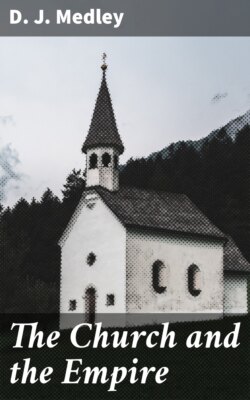The Church and the Empire

Реклама. ООО «ЛитРес», ИНН: 7719571260.
Оглавление
D. J. Medley. The Church and the Empire
The Church and the Empire
Table of Contents
PREFACE
INTRODUCTORY. CHAPTER I THE BEGINNINGS OF CHURCH REFORM. CHAPTER II GREGORY VII AND LAY INVESTITURE. CHAPTER III THE END OF THE QUARREL. CHAPTER IV THE SECULAR CLERGY. CHAPTER V CANONS AND MONKS. CHAPTER VI ST. BERNARD. CHAPTER VII THE SCHOOLMEN AND THEOLOGY. CHAPTER VIII GUELF AND GHIBELLINE (I) CHAPTER IX INNOCENT III. CHAPTER X THE PAPAL POWER IN THE CHURCH. CHAPTER XI DOCTRINE AND DISCIPLINE OF THE CHURCH. CHAPTER XII HERESIES. CHAPTER XIII THE MENDICANT ORDERS. CHAPTER XIV THE CHURCH AND THE HEATHEN. CHAPTER XV GUELF AND GHIBELLINE (II) CHAPTER XVI THE FALL OF THE EMPIRE AND OF THE PAPACY. CHAPTER XVII THE CHURCHES OF THE EAST
CHAPTER I
THE BEGINNINGS OF CHURCH REFORM
CHAPTER II
GREGORY VII AND LAY INVESTITURE
CHAPTER III
THE END OF THE QUARREL
CHAPTER IV
THE SECULAR CLERGY
CHAPTER V
CANONS AND MONKS
CHAPTER VI
ST. BERNARD
CHAPTER VII
THE SCHOOLMEN AND THEOLOGY
CHAPTER VIII
GUELF AND GHIBELLINE. (I)
CHAPTER IX
INNOCENT III
CHAPTER X
THE PAPAL POWER IN THE CHURCH
CHAPTER XI
DOCTRINE AND DISCIPLINE OF THE CHURCH
CHAPTER XII
HERESIES
CHAPTER XIII
THE MENDICANT ORDERS
CHAPTER XIV
THE CHURCH AND THE HEATHEN
CHAPTER XV
GUELF AND GHIBELLINE. (II)
CHAPTER XVI
THE FALL OF THE EMPIRE AND OF THE PAPACY
CHAPTER XVII
THE CHURCHES OF THE EAST
Отрывок из книги
D. J. Medley
Being an Outline of the History of the Church from A.D. 1003 to A.D. 1304
.....
[Sidenote: German opposition.]
The weak point in the decree of Nicholas II had been that the German clergy were not represented at the Council which issued it, and it was construed in Germany as a manifest attempt of the reforming party to secure the Papacy for Italy as against the German influence maintained by Henry III. The Roman nobles also had seen in the decree the design of excluding them from any share in the election. It was only by the introduction of Norman troops into Rome that the new Pope could be installed at the Lateran. A few weeks later a synod met at Basle in the presence of the Empress-Regent and the young Henry IV. The latter was invested with the title of Patrician, and the election of Alexander having been pronounced invalid, a new Pope was chosen in the person of another Lombard, Cadalus Bishop of Parma, who had led the opposition to the Patarins in the province of Milan. The Normans were recalled to their dominions, and the imperialist Pope, Honorius II, was installed in Rome. The struggle between the rival Popes lasted for three years (1061-4), and fluctuated with the fluctuations of power at the German court. Here the young King had fallen under the influence of Archbishop Hanno of Köln, who, surrounded by enemies in Germany, hoped to gain a party by the betrayal of imperial interests in the recognition of the decree of Nicholas II and of the claims of Alexander. Again by the help of a Norman force Alexander was installed in Rome, where he remained even when Hanno's influence at the German court gave way to that of Archbishop Adalbert of Bremen. Honorius, however, despite the desertion by the imperialist party, found supporters until his death in 1072, and it was only by the arms of Duke Godfrey of Tuscany acting for the imperialists and those of his own Norman allies that Alexander held Rome until his death.
.....